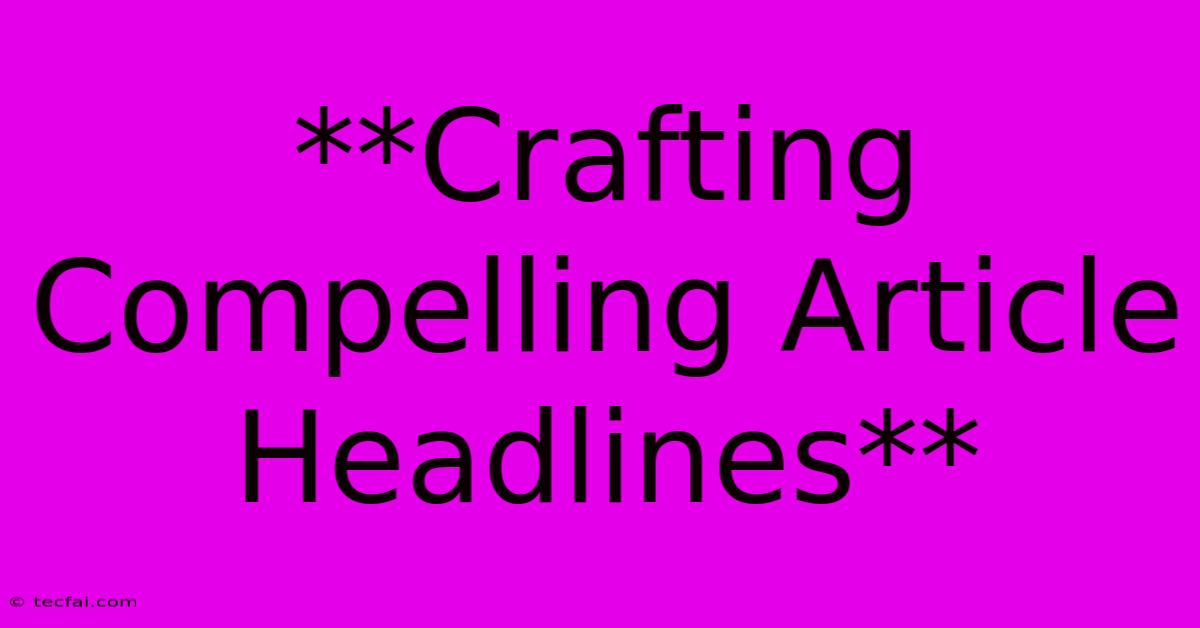**Crafting Compelling Article Headlines**

Discover more detailed and exciting information on our website. Click the link below to start your adventure: Visit Best Website tecfai.com. Don't miss out!
Table of Contents
Crafting Compelling Article Headlines: The Ultimate Guide to Captivating Readers
In the vast digital landscape, where attention spans are fleeting and content floods the internet, a captivating headline is your key to unlocking readership. It's the first impression, the siren call that beckons readers to delve into your article. Crafting a compelling headline isn't just about choosing catchy words; it's a strategic art that demands understanding your audience and the power of language.
Why Are Headlines So Crucial?
- First Impression: The headline is the first thing your audience sees, and it makes or breaks their decision to click and read.
- Traffic & Engagement: A strong headline attracts more clicks, leading to increased website traffic and higher engagement rates.
- Search Engine Optimization (SEO): Headlines play a vital role in SEO, influencing your website's visibility in search engine results pages (SERPs).
The Art of Crafting Compelling Headlines
1. Understand Your Audience:
- Who are you writing for? Identify your target audience's interests, pain points, and language preferences.
- What are their needs and desires? Tailor your headlines to address their specific concerns or aspirations.
2. Focus on Benefits & Value:
- What's in it for the reader? Clearly state the benefits they will gain by reading your article.
- Use action verbs: "Learn," "Discover," "Master," "Boost," "Unlock" – these words evoke a sense of value and action.
3. Include Specifics & Numbers:
- Be precise and quantifiable. "7 Steps to..." or "5 Ways to..." are more compelling than vague headlines.
- Numbers attract attention and convey a sense of credibility.
4. Employ Emotion & Curiosity:
- Spark curiosity: "The Secret to..." or "What Nobody Tells You..." pique reader interest.
- Use emotional words: "Amazing," "Shocking," "Delightful" evoke strong emotions and connection.
5. Keep It Concise & Clear:
- Brevity is key: Aim for headlines under 60 characters, as these are typically truncated in search results.
- Use simple language: Avoid jargon or complex sentence structures.
6. Leverage Keywords:
- Incorporate relevant keywords that align with your article's topic.
- Use a natural flow: Don't stuff your headline with keywords; integrate them seamlessly.
7. Test and Refine:
- Analyze headline performance: Track click-through rates (CTR) and other metrics to identify what works best.
- Experiment with different variations: Test A/B headlines to see which resonates with your audience.
Headline Formula Examples:
The "How-To" Headline: "How to Write SEO-Friendly Blog Posts That Rank" The "List" Headline: "5 Essential Tools for Digital Marketers" The "Question" Headline: "Are You Making These Common Content Marketing Mistakes?"
Remember: A compelling headline is the key to capturing attention and engaging your audience. By understanding your audience, focusing on value, and employing strategic writing techniques, you can craft headlines that drive traffic, increase engagement, and elevate your content.

Thank you for visiting our website wich cover about **Crafting Compelling Article Headlines**. We hope the information provided has been useful to you. Feel free to contact us if you have any questions or need further assistance. See you next time and dont miss to bookmark.
Featured Posts
-
Gout Gout Runs 200m In 20 29 Seconds
Nov 04, 2024
-
Canada Post Strike Mandate Negotiations Continue
Nov 04, 2024
-
Jayden Daniels Sinks Giants Another Loss
Nov 04, 2024
-
Saints Vs Panthers X Factor On The Field
Nov 04, 2024
-
Lions Vs Packers Highlights Week 9
Nov 04, 2024
